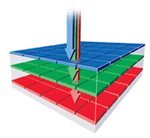Foveon Digital Camera Technology
Published by marco on
 I’m still waiting on my next digital camera. Foveon is the technology I want, I just don’t know of any cameras that use it (or that are in my price range).
I’m still waiting on my next digital camera. Foveon is the technology I want, I just don’t know of any cameras that use it (or that are in my price range).
The diagram to the left shows the technology behind this successor to the standard CCD:
“The layers are positioned to take advantage of the fact that silicon absorbs different wavelengths of light to different depths, so one layer records red, another layer records green and the other layer records blue. This means that for every pixel location on Foveon X3 image sensors, there’s actually a stack of three photodetectors, forming the first and only full-color image sensors.”
There is a full description with more pretty diagrams available at Why X3 is better.
Mosaic Without Blur Filter

Mosaic With Blur Filter

Foveon X3

Since Foveon detectors don’t have to compromise on which color to detect at which pixel, all three values are represented equally instead of using “50% of pixel locations to capturing green light, with the remaining 50% evenly divided between red and blue” (the human eye is much more sensitive to green than red or blue — digital movie formats like MPEG take advantage of this fact as well in order to get higher compression). Cameras using Foveon detectors also don’t have to do “complex processing … to interpolate the information mosaic image sensors miss” and hence don’t need to apply “blur filters [to] reduce artifacts”, which reduces the “resolution and sharpness” of the stored image.
The images to the right compare the classic, “mosaic” capture device, both filtered (note the softness added by filtering) and unfiltered (note the artifacts that arise from interpolation) and the Foveon capture device, which is crisp, has no artifacts and is far more faithful to the original color.
Since each pixel is the now the same, the Foveon can also support grouping pixels together, which reduces the perceived resolution, but “increases the signal-to-noise ratio, allowing the camera to take full-color pictures in low-light conditions”. In this way, resolution (which is often higher than needed for a lot of situations) can be scaled back in order to provide higher signal quality; at the same time, this “allows the image sensor to run at higher frame rates” so it can capture pictures at a much faster rate than large CCDs.
This feature makes it possible to capture both images and video with the same detector, “[a]nd since the sizing of pixels can be done in an instant, a Foveon X3 image sensor can capture a high-resolution still photo in the midst of recording video.”
The Foveon also supports a feature called “windowing”, which is probably familiar to photographers, enabling “enabling auto-focus, digital zoom and zone metering.” It is possible to “digital zoom into any region of an image” without repositioning the camera or sensor.
Where can you get this revolutionary thing? From the Sigma Corporation, which has a camera called the S9, which also uses the RAW file format internally, to provide lossless compression. Missing from their pile of statistics and figure, though, is a price, which I presume is a bad sign.
It is a bad sign. I’ve since found that Photo.net is selling it for a mere USD$3000.
Looks like we’re in for a wait on Foveon Technology.